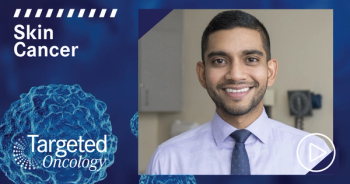
Case 1: Treatment Options for Locally Advanced cSCC
EXPERT PERSPECTIVE VIRTUAL TUMOR BOARD
Ahmad Tarhini, MD, PhD:From a surgical perspective, how do you define locally advanced squamous cell carcinoma?
Kevin S. Emerick, MD:I think we can break that down into a couple of different groups. One is this idea of an absolute contraindication of surgery, that we can’t remove it without life-threatening consequences. In the head and neck region, that means invasion in the scalp all the way down into the sagittal sinus, for example. Or in the neck, down to the internal carotid artery. Those are 2 really big, obvious, absolute contraindications. But especially within the head and neck, there are a lot of other relative contraindications.
For example, thinking about invasion in the eye, or invasion into the ear that would require complete removal of the ear; or complete removal of the nose. Other really important functional things. Does the tumor go down into the facial nerve that would impact on facial nerve function? Or around the mouth? Perioral tumors can be considered locally advanced because of their functional impact as well.
And then there’s size. I don’t know what that specific number is. It might be different in certain areas, but generally that really large tumorwhether that’s 6 cm on the cheek, or 10 or 15 cm on the scalp—is another way of considering something to be locally advanced.
Ahmad Tarhini, MD, PhD:That’s very interesting. In academic institutions where we all practice, we take advantage of a multidisciplinary tumor board. What is your advice for the community practitioner in terms of involving a multidisciplinary team? Who should be involved?
Kevin S. Emerick, MD:I think that’s a really critical aspect for these patients in their care, having the input of surgical oncology, dermatology, medical oncology, and radiation oncology. And ideally, they would be people, in all of those disciplines, who have a specific interest and expertise in cutaneous malignancy. There are lots of translatable experiences from other tumors, but this field is changing in a way that’s pretty quick. Therefore, I think it is important to have people who are routinely seeing and taking care of these patients and are up to date on the evolving treatments.
Ahmad Tarhini, MD, PhD:And in approaching this patient from a surgical standpoint, what are the key factors that you consider in determining resectability? And if you can add, what are your expectations in terms of potential cure rate, let’s say, for the surgical approach?
Kevin S. Emerick, MD:I think the first thing is answering that easy question of, are there any absolute contraindications to a surgical resection? And then, next is thinking about that next layer. In a case like this, where it’s in the postauricular region, what did that imaging show? Does this go down into bone? Does this require removing the entire ear? These are some of the critical things that help guide that discussion about whether surgery is the best next step for them. I don’t think a patient understands what that surgical resection would look like.
Another consideration, from a surgical resection standpoint, is thinking about the high-risk features that we discussed. This patient has at least a 20% risk of having an occult lymph node metastasis. And so, thinking about the potential role of sentinel lymph node biopsy within the surgical management of a patient like this.
Ahmad Tarhini, MD, PhD:Understood. So, the potential role; what patients, roughly, or what features would make you go for a sentinel lymph node biopsy?
Kevin S. Emerick, MD:I think we have some good data to suggest that if you have 2 of those high-risk features, that puts you in that 20% risk category. And if we think of our historical experience with melanoma, with other solid tumors, once you get into that perhaps 10%, or certainly 15% to 20% risk of occult metastasis, this is a population for which we’ve always thought about doing some kind of sentinel lymph node biopsy or elective lymph node dissection.
Ahmad Tarhini, MD, PhD:When resectability is uncertain, this is when we obviously think of potential radiation therapy or systemic therapy. What is your take on the role of radiation therapy?
Kevin S. Emerick, MD:I think the first thing for the surgeons is to be really up front and honest about whether the tumor is resectable. It’s about their confidence in being able to get a clear margin. Radiation can certainly be helpful in the adjuvant setting. But in that primary setting, it can still be helpful as well. Many of these tumors are very responsive to radiation. And so, that should be part of the discussion when patients are not surgically resectable.
Ahmad Tarhini, MD, PhD:Dr Wong, what is your take on the role of systemic therapy? What options are available for a patient like this?
Deborah J. Wong, MD, PhD:In the setting where we do have a local therapy option availablebe it primary surgery, or for patients who are not candidates for surgery, primary radiation—if it truly is a tumor that is quite locally advanced, in the appropriate patient one could consider the addition of, for example, radiosensitizing chemotherapy, of course extrapolating from the data in squamous cell cancers of the head and neck arising from other locations.
Beyond local therapy optionsif the patient does not have a local therapy option—then, traditionally cytotoxic chemotherapy. For example, platinum-based chemotherapy would be a reasonable option. Anti-EGFR antibody therapy, such as cetuximab, would also be considered. The newest data, which have been very exciting, have been the availability of antiPD-1 [anti–programmed cell death protein 1] immunotherapy, cemiplimab, for these patients.
Transcript edited for clarity.







































